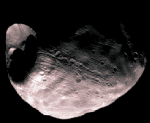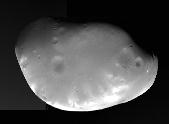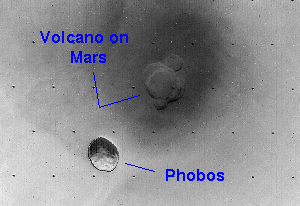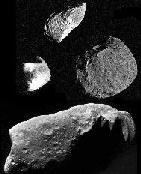 |
 |
| Phobos (Ref) | Deimos (Ref) |
Mars has two small moons that are illustrated in the following figures, Phobos and Deimos.
 |
 |
| Phobos (Ref) | Deimos (Ref) |
These are examples of what are called minor satellites: small chunks of rock in orbit around planets as compared with large satellites like the Earth's Moon. As the adjacent images show, they are very irregular in shape. Phobos is 27 km long in its longest dimension and Deimos is 15 km long in its longest dimension.
 Both are
cratered and orbit the planet in rather low orbits. Phobos is only about 3000
miles above the Martian surface and orbits in a little over 7 hours (thus it
makes more than 3 orbits in a single Martian day). Deimos is
a little further out and orbits in about 30 hours.
Both are
cratered and orbit the planet in rather low orbits. Phobos is only about 3000
miles above the Martian surface and orbits in a little over 7 hours (thus it
makes more than 3 orbits in a single Martian day). Deimos is
a little further out and orbits in about 30 hours.
The figure to the right
(Ref)
shows a rather spectacular image taken by the Viking 2 orbiter from an
altitude of about 8000 miles above the Martian surface. The image
looks down on a Martian shield volcano (Ascraeus Mons) which is about 200 miles
across and in the center. The object down and to the left of the volcano is
Phobos, which is 5000 miles below the orbiter, and 3000 miles above the Martian
surface! (The regular horizontal rows
of dots seen in the image are an artifact associated with the imaging;
they don't correspond to real features.)
 These moons of Mars were not formed in the same way as the Earth's Moon. They
are probably fragments of larger objects broken apart in a collision. Such
moons may be formed from collisions of objects originally in orbit around the
planet, or they might also have been captured gravitationally at some point in
the past.
These moons were probably captured as asteroids from the asteroid
belt from fragments deflected by Jupiter. Subsequent
collisions actually slowed the fragments enough to be capture
into orbit around Mars.
These moons of Mars were not formed in the same way as the Earth's Moon. They
are probably fragments of larger objects broken apart in a collision. Such
moons may be formed from collisions of objects originally in orbit around the
planet, or they might also have been captured gravitationally at some point in
the past.
These moons were probably captured as asteroids from the asteroid
belt from fragments deflected by Jupiter. Subsequent
collisions actually slowed the fragments enough to be capture
into orbit around Mars.
The moons are aspherical because gravity is too weak to overcome the rock stresses. Smaller moons are generally less spherical.
The nearer moon, Phobos has less dust because it is nearer from Mars and is less able to gravitationally hold onto its residual dust from its cratering than Deimos. Deimos can hold onto its dust because it is far enough away from Mars that self gravity dominates Mars' pull on the dust.
Phobos will get shredded by tidal forces from Mars in about 100 million years.
The adjacent image
(Ref)
compares the appearance of several minor
satellites of the Solar System
(Phobos, Deimos, Gaspra, and Ida). We shall encounter many such small moons
around the giant planets like Jupiter and Saturn.